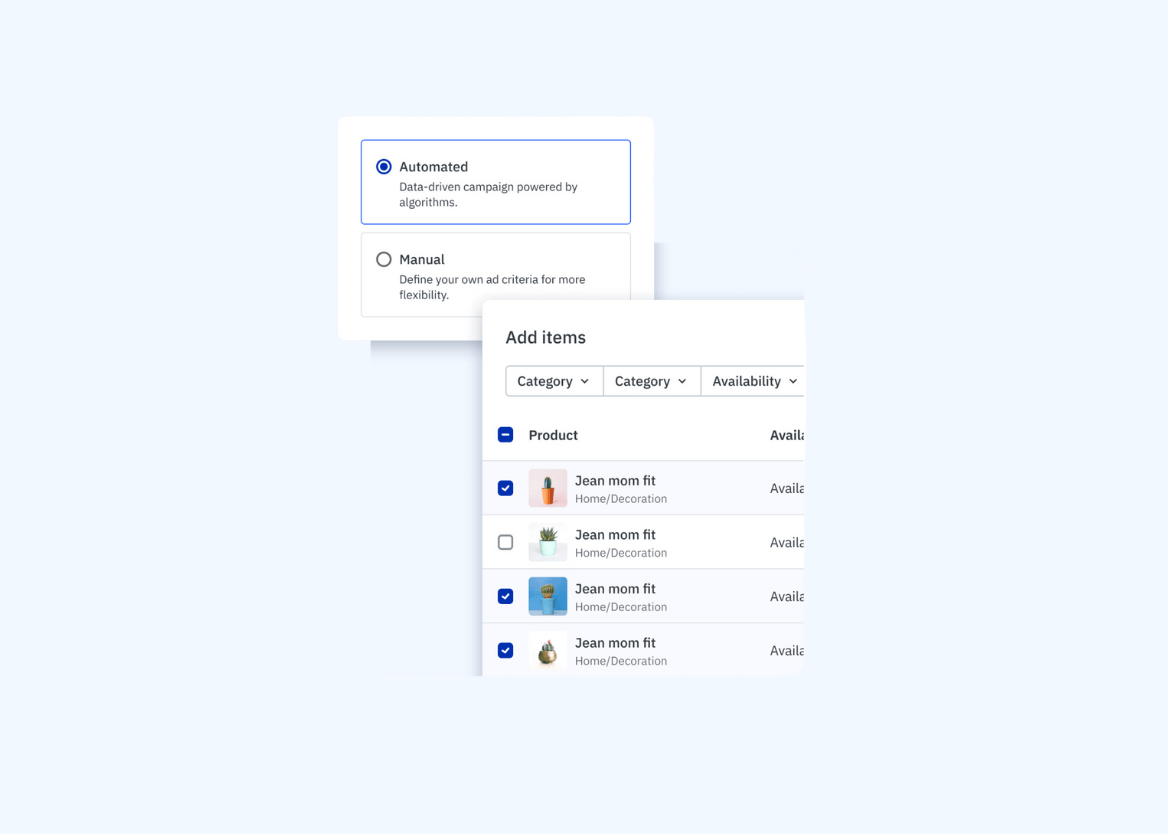A retailer’s guide to key retail media ad formats

As retailers look to diversify and strengthen high-margin revenue streams, running a retail media network has become one of the most profitable growth engines in commerce. But understanding how to capture that value starts with understanding the types of retail media ad formats that drive it and where your network can play in this space.
This guide breaks down three core categories of ad inventory you can offer through your own retail media network — on-site, off-site, and in-store — and explores what each means for advertisers and your bottom line.
1. On-site, full-funnel advertising
On-site advertising sits at the heart of every successful retail media network. It encompasses all formats that appear directly within your owned digital environments — from sponsored product ads to display banners and video — across search results, category pages and product pages.
On-site ads are among the best-performing campaign types because they reach shoppers as they actively browse, research and buy. Served on your website or app, these placements leverage your first-party data and deliver highly contextual targeting with precision, across the entire funnel, from awareness through conversion.
Value to advertisers
For advertisers, on-site is the most efficient, measurable and performance-driven format available. It allows them to:
Target high-intent shoppers closest to the purchase.
Measure true return on ad spend (ROAS) and precious data to improve campaigns in real time.
Revenue and margin opportunity for retailers
For retailers, on-site advertising is the cornerstone of a successful retail media strategy. It offers:
Real time control of the shopping experience. (This is especially true with regard to self-service technology such as Mirakl, where placements and pricing can be managed in real time.)
Highest profit margins, often reaching 70-80% due to owned inventory and minimal overhead.
As more brands participate, competition drives higher CPCs and CPMs, compounding network revenue. On-site is where your retail media network revenue story begins, and where the most sustainable profitability lies.
2. Off-site ad extensions
While on-site is the gold standard, off-site ad formats extend your influence (and your data’s value) across the broader web. These campaigns use your first-party shopper insights to reach audiences on platforms like Google shopping, Meta, TikTok or open-web display networks.
Off-site extensions activate your retailer data through demand-side platforms or partnerships to target existing customers or lookalike audiences wherever they spend time online. Campaigns can retarget lapsed shoppers, drive return visits or reach new buyers who mirror your best customers.
Value to advertisers
For advertisers, off-site ads bridge upper- and lower-funnel objectives. They allow:
Consistent messaging and frequency across multiple touchpoints.
Access to your retailer’s verified audiences for superior targeting precision.
Seamless integration of brand storytelling and performance media.
Off-site is particularly powerful when connected to your on-site campaigns, creating a continuous loop of engagement and measurement.
Revenue and margin opportunity for retailers
For retailers, off-site opens a new class of retail media network revenue, capturing budgets from brand and performance teams that historically flowed into programmatic or social media. While margins are typically lower than on-site (due to external media costs), off-site advertising:
Expands total advertiser spend under your network.
Monetizes data beyond your owned properties.
Brings back shoppers to retailers' websites for higher traffic and better retention.
Retailers working with retail media partners like Mirakl can automate this process, extending their first-party audience power to new demand sources with minimal lift.
3. In-store digital display
Digital transformation doesn’t stop at the screen. In-store retail media takes your data-driven approach into the physical world, turning stores into high-value media networks in their own right.
In-store displays, kiosks, shelf screens and digital signage bring dynamic messaging to real-world shopping environments. They can promote limited-time offers, seasonal campaigns or contextually-relevant products in high-traffic areas.
Value to advertisers
For advertisers, in-store media reconnects physical shoppers with digital targeting precision.
In-store media means brands can:
Deliver real-time promotions tied to shopper profiles.
Reach audiences who are difficult to engage through digital-only channels.
Measure on-site exposure impact, with Research Online, Purchase Offline (ROPO) effect.
In-store retail media aligns trade marketing, shopper marketing and digital advertising into one cohesive experience.
Revenue and margin opportunity for retailers
For retailers, in-store media unlocks incremental revenue streams from brand partners already investing heavily in physical retail. Although hardware and operational costs mean margins are lower than on-site placements, the channel offers:
Access to trade and co-op budgets.
Stronger brand partnerships through integrated campaign packages.
A way to monetize every square foot of retail space.
As part of an omnichannel retail media network, in-store display completes the picture, bridging digital precision with physical engagement.
Best practice: Build your retail media network around on-site, then expand
Each of these formats — on-site, off-site, and in-store — plays a critical role in a modern retail media ecosystem. But on-site advertising remains the foundation: it delivers the highest margins, fastest execution and deepest shopper insights, all while making the most use of retailers’ valuable first-party data.
Once a retailer has built a strong on-site program, expanding into off-site extensions and in-store displays becomes both simpler and more profitable. Together, these formats transform your data, digital properties and physical stores into a connected, high-margin advertising engine.



